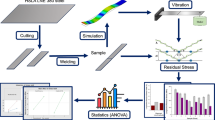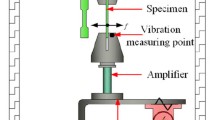Abstract
This study investigates the microstructures and mechanical properties of 304 stainless steel at various vibration frequencies during simultaneous vibration welding. The experimental results demonstrated that simultaneous vibration welding could accelerate the nucleation and grain refinement of the microstructures. The effect of the grain refinement was more evident at the resonant frequency (375 Hz) and a minimum content of residual δ-ferrite (4.0%). The γ phase grew in the preferential orientation of the (111) direction with and without vibration. The full width at half maximum of the diffraction peak widened after the vibration, which was attributed to the grain refinement. The residual stress could be efficiently removed through simultaneous vibration welding when the amplitude of the vibration was increased. Furthermore, the lowest residual stress (139 MPa) was found when the vibration frequency was 375 Hz. The hardness and Young’s modulus exhibited slight increases with low and medium frequencies. The hardness values were increased by 7.6% and Young’s modulus was increased by 15% when the vibration frequency was resonant (375 Hz).
Similar content being viewed by others

Explore related subjects
Discover the latest articles and news from researchers in related subjects, suggested using machine learning.References
H. C. Chen, Structural Strength of Welding, 1st ed., p.200, Fu-Wen Book Company, Taiwan (1995).
H. S. Chou, Weld. Cutt. 2, 83 (1992).
Y. C. Lin, Mech. Techno. 48, 48 (1989).
E. Enke, Maschinenmarkt 48, 37 (1955).
A. G. Hebel, Jr., Metal Process. 128, 51 (1985).
C. A. Walker, A. J. Waddell, and D. J. Johnston, Process Inst. Mech. Eng. 209, 51 (1995).
Meta-Lax, Meta-Lax Stress Relief Procedure, 1st ed., pp.1–120, Bonal Technologies, Inc., Royal Oak, Michigan (1997).
I. K. Lokshin, Dimensional Stabilization of Casting, 1st ed., pp.1–35, Russian Castings Production, Russia (1965).
C. A. Walker, A. J. Waddell, and D. J. Johnston, Process Inst. Mech. Eng. 209, 65 (1995).
R. Dawson and D. G. Moffat, J. Eng. Mater. Technol. 102, 169 (1980).
M. C. Sun, Mater. Lett. 58, 299 (2004).
D. Rao, D. Wang, L. Chen, and C. Ni, Int. J. Fatigue 29, 192 (2007).
C. W. Kuo, C. M. Lin, G. H. Lai, Y. C. Chen, Y. T. Chang, and W. Wu, Mater. Trans. 48, 2319 (2007).
C. W. Kuo, M. C. Chen, J. H. Chen, G. H. Lai, Y. T. Chang, Y. C. Chen, and W. Wu, Mater. Trans. 48, 2316 (2007).
S. Weiss, S. Baker, and R. D. Das Gupta, Weld. J. 55, 47 (1976).
Q. Lu, L. Chen, and C. Ni, Mater. Sci. Eng. A 457, 246 (2007).
B. Wei, Acta Metall. 40, 2739 (1992).
C. W. Kuo, Ph. D. Thesis, pp.1–80, National Chung Hsing University, Taiwan (2008).
N. Suutala, T. Takalo, and T. Moisio, Metall. Mater. Trans. A 11, 717 (1980).
H. P. Chou, Mech. J. 18, 155 (1992).
C. M. Wang, Materials Analysis, 1st ed., pp.1–230, Materials Research Society, Taiwan (1998).
E. Beraha and B. Shpigler, Color Metallography, 1st ed., pp.1–58, American Society for Metals, Metals Park, Ohio (1977).
M. E. Hilley, J. A. Larson, C. F. Jatczak, and R. E. Richlefs, Residual Stress Measurement by X-ray Diffraction, 1st ed., pp.1–30, SAE Information Report, Warrendate, Pennsylvania (1971).
G. F. Vander Voort, Metallography: Principles and Practice, 1st ed., pp.1–155, McGraw-Hill Book Co., New York, (1984).
D. Y. Lin, G. L. Liu, T. C. Chang, and H. C. Hsieh, J. Alloys Compd. 377, 150 (2004).
S. E. Hsu and T. P. Wu, X-Ray Diffraction Principles and Materials Structural Analysis, 1st ed., pp.1–235, Materials Research Society Taiwan (1992).
G. P. Wonzney and G. R. Crawmer, Weld. J. 47, 411 (1968).
Author information
Authors and Affiliations
Corresponding author
Rights and permissions
About this article
Cite this article
Hsieh, CC., Lai, CH. & Wu, W. Effect of vibration on microstructures and mechanical properties of 304 stainless steel GTA welds. Met. Mater. Int. 19, 835–844 (2013). https://doi.org/10.1007/s12540-013-4026-2
Received:
Accepted:
Published:
Issue Date:
DOI: https://doi.org/10.1007/s12540-013-4026-2
Key words
Profiles
- Weite Wu View author profile



